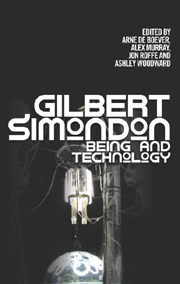Book contents
- Frontmatter
- Contents
- Abbreviations
- Editors' Introduction: Simondon, Finally
- 1 Technical Mentality
- Explications
- 2 ‘Technical Mentality’ Revisited: Brian Massumi on Gilbert Simondon
- 3 Identity and Individuation: Some Feminist Reflections
- 4 Crystals and Membranes: Individuation and Temporality
- Implications
- Resonances
- Glossary: Fifty Key Terms in the Works of Gilbert Simondon
- Notes on Contributors
- Index
4 - Crystals and Membranes: Individuation and Temporality
from Explications
Published online by Cambridge University Press: 12 September 2012
- Frontmatter
- Contents
- Abbreviations
- Editors' Introduction: Simondon, Finally
- 1 Technical Mentality
- Explications
- 2 ‘Technical Mentality’ Revisited: Brian Massumi on Gilbert Simondon
- 3 Identity and Individuation: Some Feminist Reflections
- 4 Crystals and Membranes: Individuation and Temporality
- Implications
- Resonances
- Glossary: Fifty Key Terms in the Works of Gilbert Simondon
- Notes on Contributors
- Index
Summary
In order to escape from what he calls the hylomorphic schema, which has oriented occidental metaphysics towards a substantialism which fore-closes becoming, Simondon transforms the philosophy of individuation. Every doctrine according to which individuation results from the impression of an exterior principle, like a mould, on to the material individual, such that form remains external to matter, invokes the this schema. By presupposing the hierarchical subordination of matter to a transcendent form, the constituted individual is considered to be explicable on the basis of a principle of individuation anterior to it. However, the presupposition of a preformed principle of individuation that transcends the operation of individuation renders the becoming of the individual as a real process impossible to explain. Simondon therefore challenges the notion that the process of individuation can be considered in a unitary manner, and refuses to presuppose that the principle of this individuation can be conceived as a formal cause exterior to the real process. Purely nominal, abstract and explicative, the principle of individuation must become the genetic principle contemporary with real individuation.
What is in question is thus no longer individuated being, being come into being, but rather the real genetic process of its transformation. Simondon's work thus opens on to a new conception of time as ontogenesis, such that becoming is no longer conceived as the becoming of individuated being, but rather as the becoming of the individuation of being.
- Type
- Chapter
- Information
- Gilbert SimondonBeing and Technology, pp. 57 - 70Publisher: Edinburgh University PressPrint publication year: 2012



